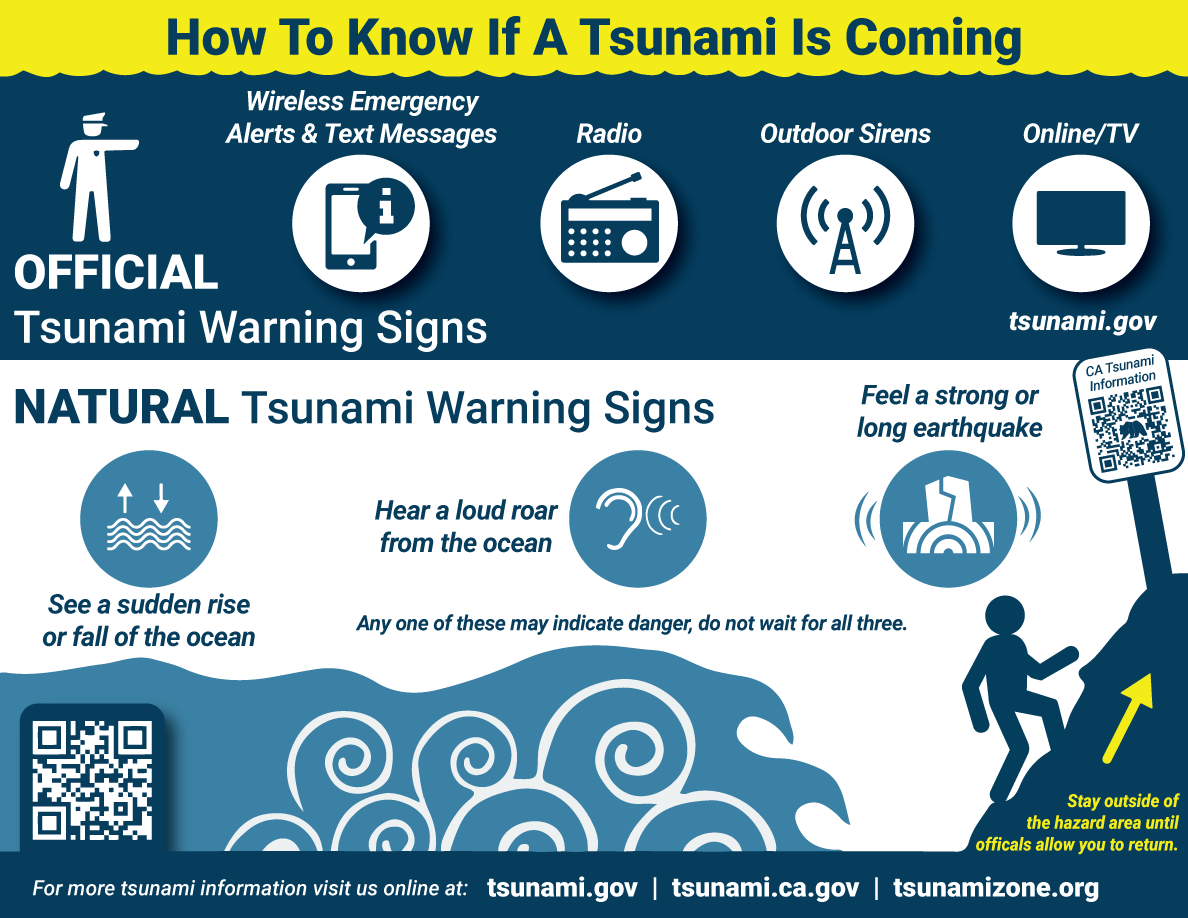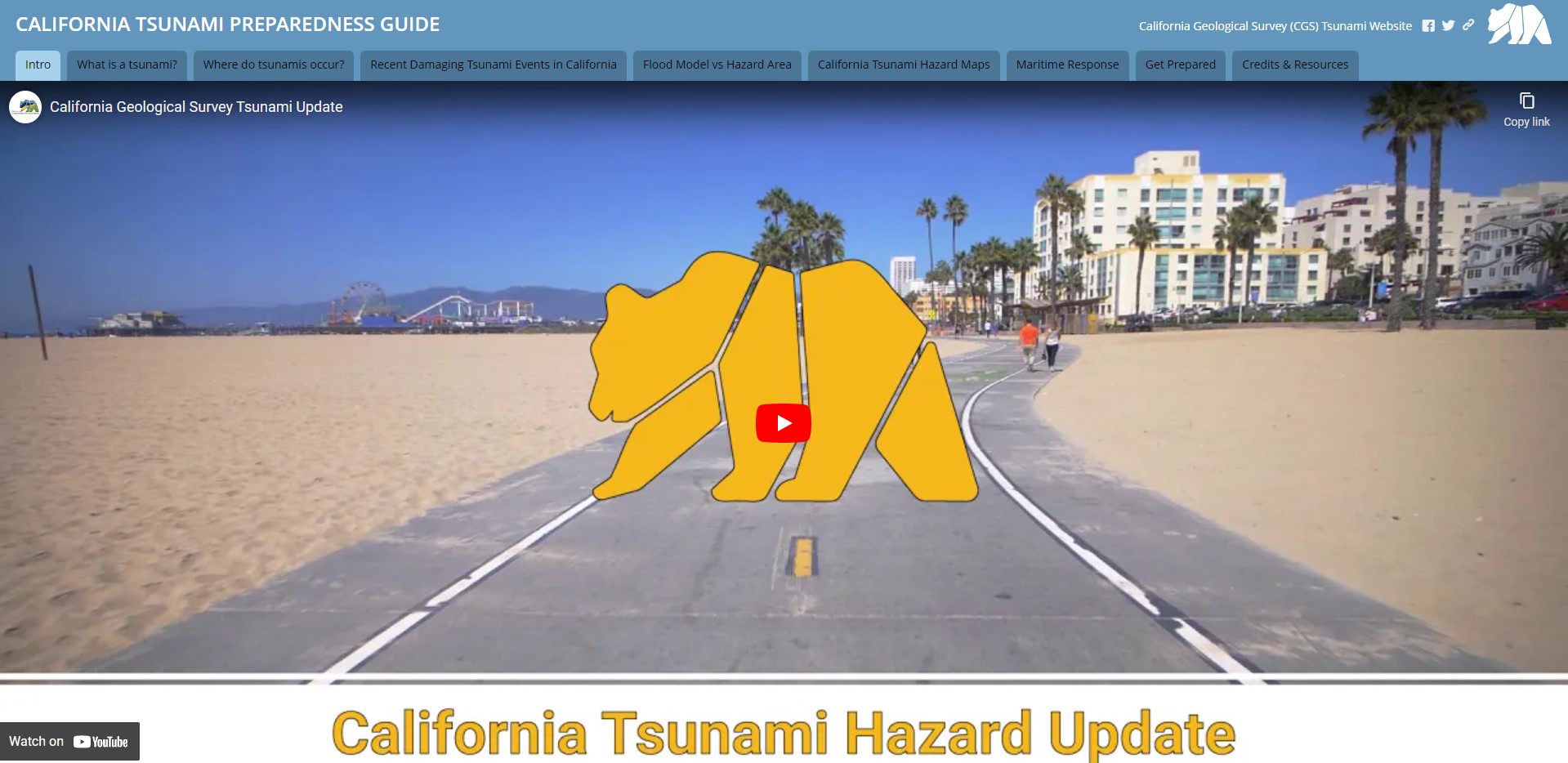Videos
Lessons Save Lives: The story of Tilly Smith- Learn about an eleven-year-old schoolgirl who was on vacation with her family when the Indian Ocean tsunami hit in December 2004. She recognized the signs of the receding sea and warned her parents of the coming tsunami. Her efforts saved the lives of dozens of people. This story highlights the critical importance of tsunami education.
Tsunamis: Know What to Do! - From the County of San Diego. An animated crab teaches students what to do in the event of a tsunami.
Tsunamis: ¡Sepa qué hacer! (subtitulado en Español) - Del condado de San Diego. Un cangrejo animado les enseña a los estudiantes qué hacer en caso de un tsunami.
Publications
Tsunami Frequently Asked Questions
What is a tsunami?
A tsunami is a wave, or series of waves, generated by an earthquake, landslide, volcanic eruption, or even large meteor hitting the ocean (The Japanese word tsu means “harbor;” nami means “wave”). What typically happens is a large submarine earthquake (magnitude 8 or higher) creates an upward movement of the sea floor, lifting the overlying seawater up. This uplifted water then falls down and radiates away from this center in all directions as a tsunami. A tsunami can travel across the open ocean at about 500-miles per hour, the speed of a jet airliner. As the wave approaches land, the ocean shallows, the wave slows down to about 30 miles per hour and grows significantly in height (amplitude).
Although most people think a tsunami looks like a tall breaking wave, it resembles a flood or surge.
What are tsunami warning signs?
In order to determine whether a tsunami has been generated following a large earthquake, scientists from the
National Tsunami Warning Center monitor an array of buoys and tide gages that measure vertical changes to the ocean surface (more info on ocean tides and currents). If a potentially damaging tsunami is headed towards California, a warning will be broadcast through the Emergency Alert System and the National Weather Service (NWS) Weather Radio. Ask your local city or county how they will notify you of a tsunami.

In situations where tsunami travel times are short (due to nearby earthquakes or landslides), it is difficult for government agencies to identify and warn the public. Individuals should know what the natural warning signs of a tsunami are and have a plan to evacuate if necessary. One noticeable, but not universal, sign is the rapid receding of ocean water from the beach before the first tsunami wave hits. In many accounts (including the 2004 Indian Ocean tsunami), this effect has caused greater loss of life because it became a curiosity that attracted people to the oceanfront.
Very strong ground shaking along the coast is an indication of an earthquake that could cause seafloor displacements and/or a submarine landslide large enough to generate a tsunami. Though many large earthquakes have occurred along the coast without causing a tsunami, you should still be aware of the potential and plan accordingly. In the event you are at the coast and feel strong shaking, it would be prudent to move to higher ground.
What are possible sources of tsunamis that might affect California?
More than eighty tsunamis have been observed or recorded in California in historic times. Fortunately, almost all of these were small and did little or no damage. While damaging tsunamis have occurred infrequently in California, they are a possibility that must be considered in coastal communities. There are two sources for California tsunamis, based on distance and warning time:
Local Sources
Local tsunami sources, like large offshore faults and massive submarine landslides, can put adjacent coastal communities at the greatest risk of a tsunami because the public must respond quickly with little or no official guidance. The Cascadia subduction zone is an example of a local tsunami source that could threaten northern California. Stretching from Cape Mendocino, California, to Vancouver Island, British Columbia, this 700-mile long submarine fault system forms the crustal plate boundary where the offshore Gorda and Juan de Fuca plates dive, or subduct, beneath the North America plate. Examples of local tsunamis that have impacted California include:
- January 26, 1700 - An earthquake estimated at a magnitude 9 ruptured the entire length of the Cascadia subduction zone, likely causing a 50-foot tsunami in parts of northern California. While there were no local written accounts, scientists have reconstructed the event based on geologic evidence and oral histories from the Native American people in the area and determined the exact date and time from Japanese documents that describe the effects of a large tsunami that hit the coast of Japan later that same day.
- December 21, 1812 – A tsunami struck the Santa Barbara and Ventura coastline shortly after a large earthquake was felt in the area. While reports of the size of this tsunami have been debated, the event was large enough to inundate lowland areas and cause damage to nearby ships. One hypothesis is that the tsunami was caused by a nearby submarine landslide triggered by the earthquake.
Distant Sources
A tsunami caused by a very large earthquake elsewhere on the Pacific Rim could reach the California coast many (4 to 15) hours after the earthquake. The Alaska-Aleutians subduction zone is an example of a distant source that has caused destructive tsunamis in California. Notable distant tsunamis that have impacted California include:
- April 1, 1946 – A magnitude 8.6 earthquake in the Aleutian Islands generated a tsunami that caused damage along the coast of California, including flooding more than 1,000 feet inland at Half Moon Bay.
- March 28, 1964 – Twelve people were killed in California when a tsunami was generated by a magnitude 9.2 earthquake off the coast of Alaska. A surge approximately 20-feet high flooded 29 city blocks of Crescent City.
- March 11, 2011 – A magnitude 9.1 earthquake in the Tōhoku region of Japan produced a moderate amplitude tsunami in California. While it did not generate significant flooding in California, strong tsunami currents caused one death and over $100 million in damages to 27 harbors statewide, with the most significant damage occurring in Crescent City and Santa Cruz. Read more about it at our Tōhoku-oki tsunami page.
What should I do to prepare for a tsunami?
You're already off to a great start just by educating yourself!

Next, go visit our Tsunami Preparedness page. While you're there, make sure you take time to explore the California Tsunami Preparedness Guide.
Visit our Related Links page for more Tsunami Education/Information Resources
Back to the Tsunamis home page
Web page by:
California Geological Survey - Seismic Hazards Program
